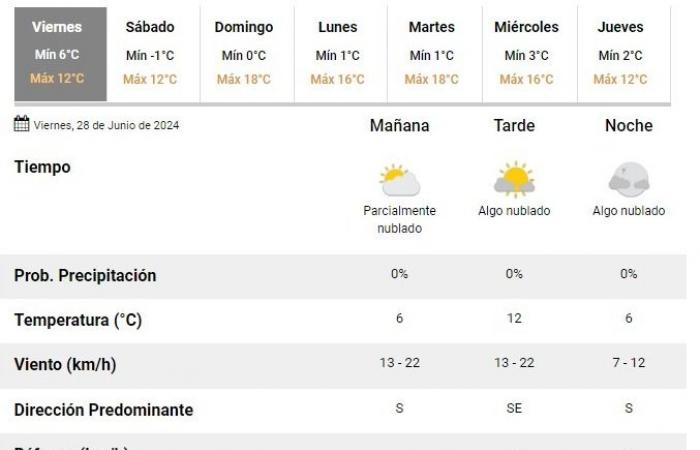According to the National Meteorological Service, the maximum temperature is expected to rise to 12°C on Friday, June 28, 2024, while the minimum temperature will fall to 6°C.
The day will be with partly to somewhat cloudy skies and wind from the south, which will rotate towards the southeast in the afternoon and close from the south again.
For the rest of the week, they predict maximum temperatures that will range between 12 and 18 degrees.
Climate of San Juan
The climate of San Juan is desert-like, with little rainfall, high aridity and a significant annual and daily temperature variation. Temperatures oscillate around the average of 32 °C in January, with maximums that exceed 39 °C and can even reach peaks of 44 °C absolute, and 8 °C in July, where frost occurs and can be frequently record temperatures below 0 °C. No month has rainfall above 20 mm, and it is more likely in summer (between December and March). Three types of zonal winds blow in San Juan: the typical Zonda, the South and the North Wind. The first comes from the west, it usually starts with heavy snowfall in the mountain area, and arrives in the city very warm and dry. It occurs more frequently in the months of August and September, due to the change of season.
The South, has a southeast direction, is more frequent than the previous one, it occurs at any time of the year. It consists of a strong wind from the south, fresh and more humid, which lasts several days, and is often accompanied by storms in summer, it is expected to refresh a previous suffocating situation of Zonda wind (prefrontal syndrome).
The North comes from this direction, blows less frequently, and carries warm and humid tropical air.
Geography of San Juan
The province has a territory whose surface area is 89,651 km², where a mountainous relief with scant vegetation, fertile oases, mountain melting rivers, mountain ranges and important mining and paleontological deposits stand out. It presents a geographical space that is geoformologically abrupt interspersed by depressed areas, where rocky outcrops predominate with little presence of evolved soil, whose location of the latter, always with very little evolution (fertility), is present in the oases -tectonic depressions filled with sediments transported by alluvium – where the largest number of population settles, whose activities are reflected in primary, secondary, tertiary and quaternary, constituting true nuclear spaces in the oases, that is, where various activities are gathered and linked that avoid the scarcity of goods. and services to enable permanent seating.






